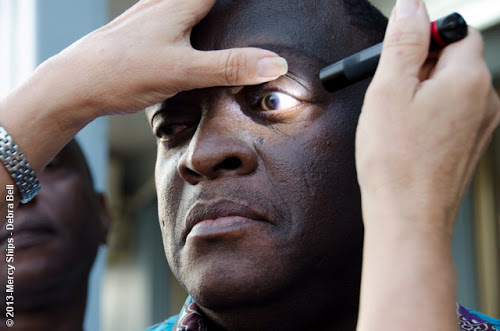Leading Eye Doctors in Andalusia: Schedule Your Appointment Today
Leading Eye Doctors in Andalusia: Schedule Your Appointment Today
Blog Article
Comprehending the Different Vision Adjustment Procedures Available for Clearer View
In the world of vision correction procedures, a wide range of alternatives exist to attend to refractive mistakes and supply people with more clear view. From the widely identified LASIK surgical procedure to much less invasive procedures like PRK and implantable lenses, the area of ophthalmology supplies a variety of strategies customized to fit various needs and preferences. Each treatment includes its very own collection of factors to consider, benefits, and possible risks. Recognizing the nuances of these vision adjustment techniques is vital for making educated choices concerning one's visual wellness. Let's discover the ins and outs of these treatments and dropped light on the course to achieving boosted vision clearness.
LASIK Surgical Procedure
LASIK surgery is an usual refractive procedure utilized to deal with vision problems such as nearsightedness, farsightedness, and astigmatism. This medical strategy, which stands for Laser-Assisted in Situ Keratomileusis, intends to reshape the cornea to improve how light is concentrated on the retina, inevitably enhancing vision clearness.
One of the primary advantages of LASIK surgery is the fast improvement in vision experienced by individuals. On the whole, LASIK surgical procedure is a popular selection for people seeking a lasting service for their vision problems.
PRK Procedure

PRK is a suitable option for people with slim corneas or those at a greater risk of eye injuries, as it does not include developing a corneal flap. The recuperation procedure for PRK is a little longer contrasted to LASIK, as the epithelium needs time to regenerate. Individuals might experience pain and blurry vision for a couple of days complying with the treatment.
Despite the longer recovery time, PRK can generate exceptional cause vision improvement, making it a valuable option for those who may not be appropriate prospects for LASIK surgical treatment. - Andalusia Pediatrics
Implantable Lenses
Unlike PRK where the cornea is reshaped directly, implantable lenses offer an additional technique for remedying vision by putting man-made lenses inside the eye. This procedure is particularly helpful for people with high levels of astigmatism, farsightedness, or nearsightedness that may not appropriate prospects for laser surgeries like LASIK or PRK.
Implantable lenses, likewise called phakic intraocular lenses, work by supplementing the eye's natural lens with a synthetic one. These lenses can be positioned in front of the all-natural lens (former chamber) or behind the iris and before the all-natural lens (posterior chamber) By adjusting the power and positioning of these lenses, eye doctors can properly correct refractive errors and improve aesthetic skill.
One benefit of implantable lenses is that they are removable and exchangeable, providing adaptability for future changes. As with any type of surgical procedure, there are dangers involved, such as infection or cataract development. Individuals considering implantable lenses need to seek advice from with an eye care professional to determine the most suitable choice based on their individual needs and eye health and wellness.
Corneal Rings

The treatment for putting corneal rings is minimally invasive and fairly quick, go now usually performed as an outpatient treatment. During the surgery, the eye doctor makes a little incision in the cornea and inserts the rings at a details deepness. When in area, the rings help to reshape the cornea, providing a smoother surface for light to get in the eye, which can lead to more clear vision.
Corneal rings are considered a relatively easy to fix procedure, as they can be removed or changed if required. While they may not entirely eliminate the requirement for glasses or call lenses, corneal rings can substantially enhance vision quality and overall visual comfort for individuals with keratoconus or other corneal irregularities.
Refractive Lens Exchange
Complying with the adjustment of corneal irregularities with treatments like corneal rings, another vision correction strategy that can deal with refractive mistakes is Refractive Lens Exchange (RLE) RLE is a procedure that involves changing the eye's natural lens with a fabricated intraocular lens (IOL) to deal with refractive mistakes such as nearsightedness, farsightedness, and presbyopia. This treatment is specifically helpful for people that may not be appropriate prospects for treatments like LASIK or PRK because of elements such as slim corneas or high refractive mistakes.
RLE is similar to cataract surgery, as both include eliminating the eye's all-natural lens; nevertheless, in RLE, the lens is clear, not cloudy as in cataracts. The fabricated lens implanted throughout RLE can be personalized to deal with the individual's specific refractive error, giving clear vision at numerous ranges. Recovery time for RLE is reasonably quick, and patients can expect improved vision quickly after the treatment. Just like any surgical procedure, prospective dangers and problems exist, so a complete appointment with an eye care expert is vital to figure out if RLE is the best vision correction option.
Conclusion

In the world of vision improvement treatments, a wide variety of options exist to attend to refractive errors and provide people with clearer view.LASIK surgery is an usual refractive treatment made use of to correct vision issues such as nearsightedness, farsightedness, and astigmatism.While additionally a typical refractive treatment, the PRK (Photorefractive Keratectomy) strategy differs from LASIK surgical treatment in its method to fixing vision problems.Following the adjustment of corneal irregularities with procedures like corneal rings, another vision correction technique that can address refractive mistakes is Refractive Lens Exchange (RLE) LASIK surgical treatment, PRK treatment, implantable lenses, corneal rings, and refractive lens exchange are all options that can attend to various vision concerns.
Report this page